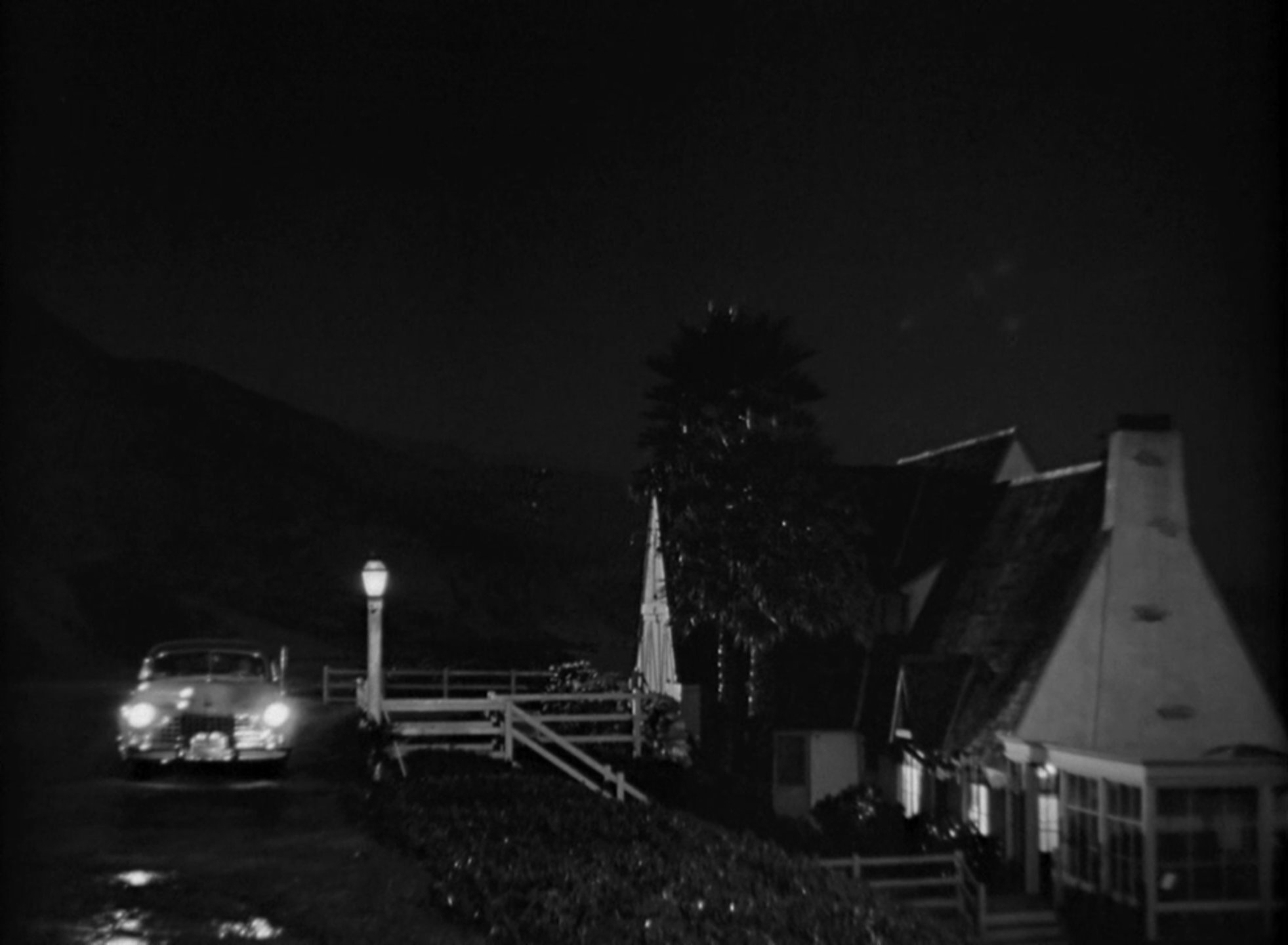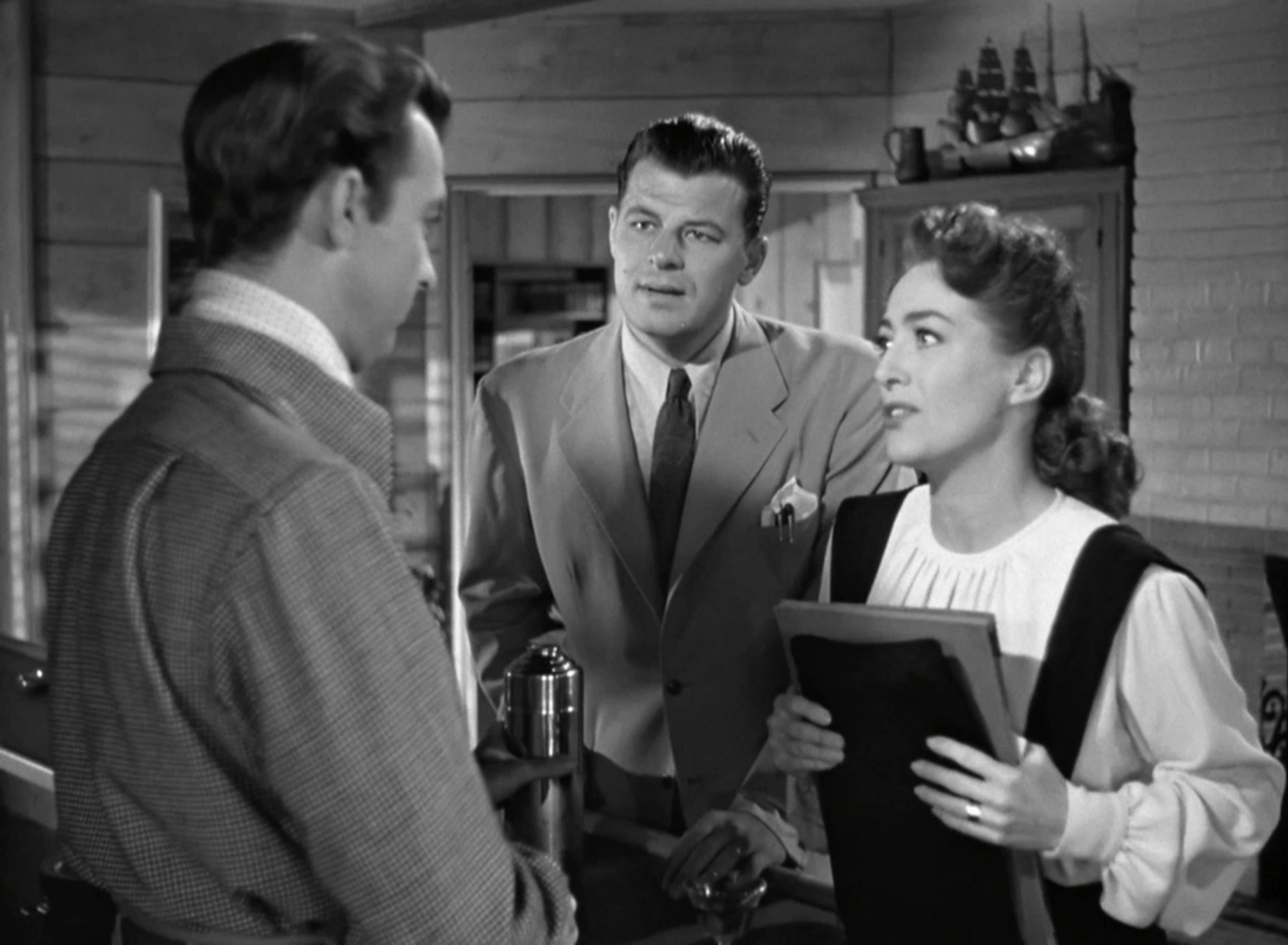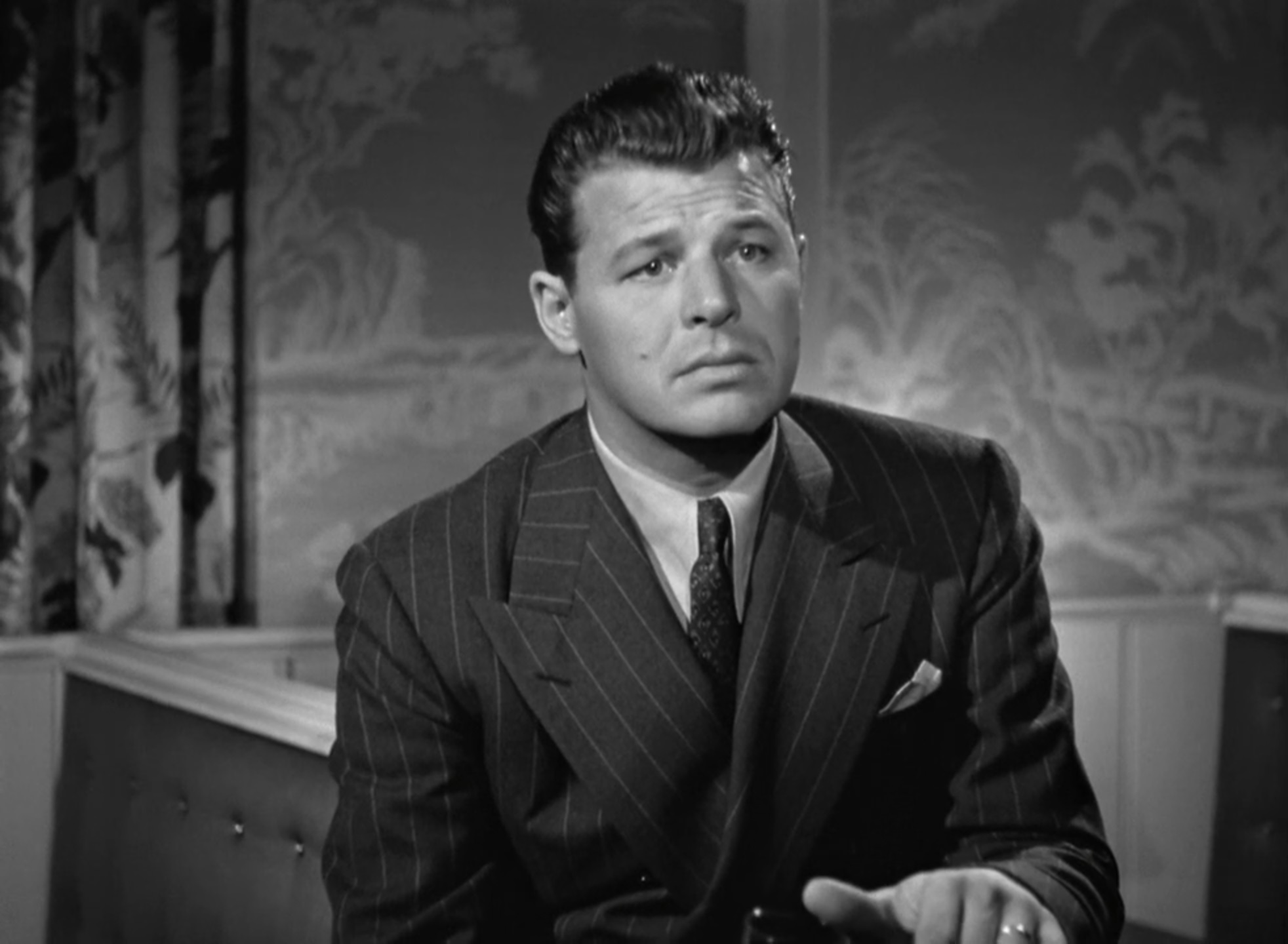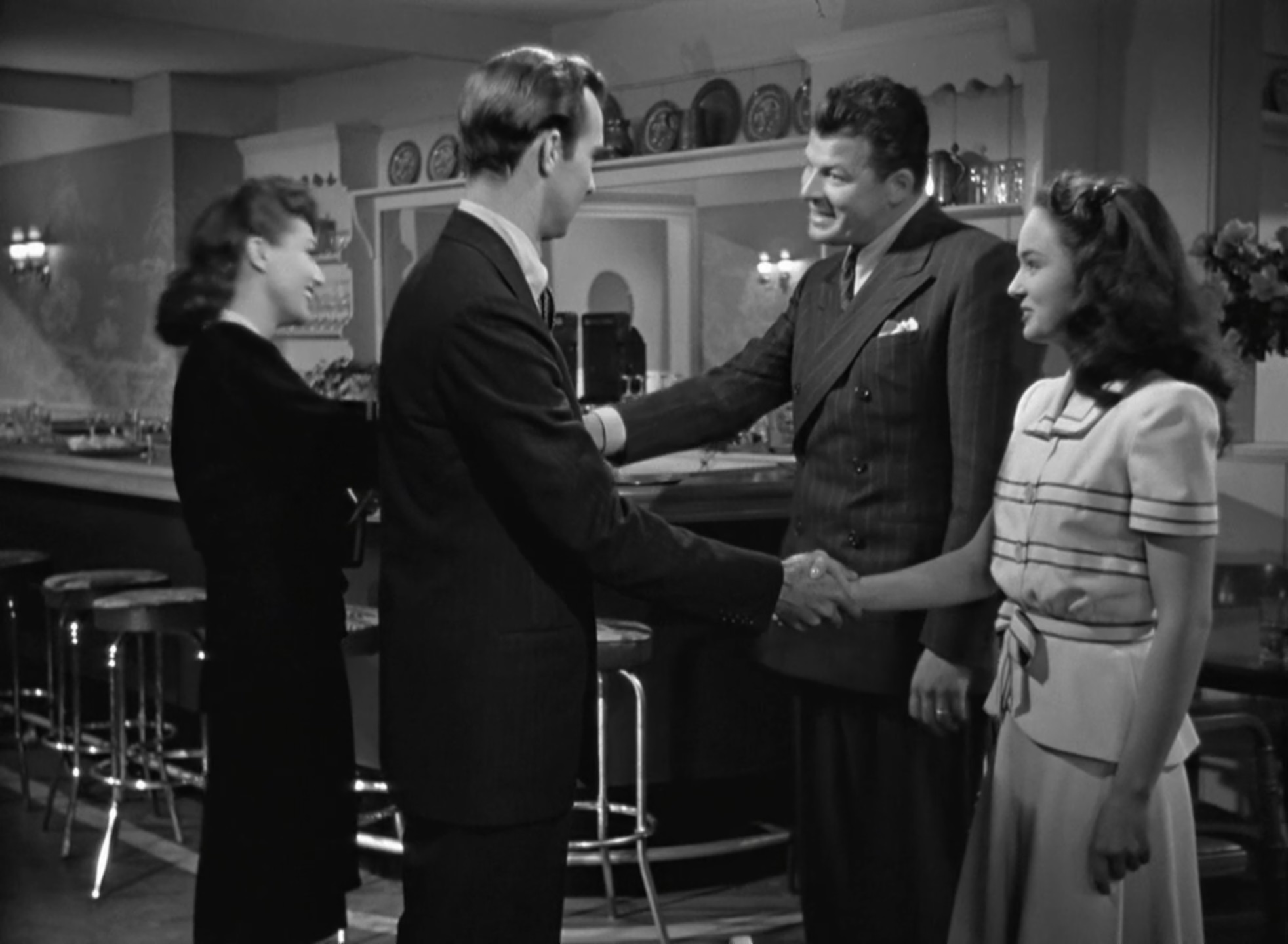 Mildred Pierce (1945) 00:01:47
February 28, 2023
Mildred Pierce (1945) 00:01:47
February 28, 2023
Filtering Through and Clarifying Cinematic Mood and a Turning Shot in Mildred Pierce (1945)
Cinematic mood is often misunderstood as merely consisting of the tone and mood of a film. One might define a film’s mood as how it makes them feel or makes them think about the film after viewing it. While these two concepts certainly serve colloquial functions for discussing, understanding, and receiving film amongst a laymen audience, they leave the holistic nature of cinematic mood an incomplete diagram. Cinematic mood might feel like a minor portion of film’s world building, or only the setting of the stage for the plot the characters will navigate, but this explanation leaves out the influence of mood in and from other cinematic elements. In this essay I will unpack an understanding of cinematic mood from two texts, “Art Moods and Human Moods in Narrative Cinema” and “Stimmung: Exploring the Aesthetics of Mood”, by Carl Plantinga and Robert Sinnerbrink respectively, to explain the holistic nature of cinematic mood, and then show why a particular shot in the restaurant of Mildred Pierce (1945) is one of the most pivotal and consequently moody shots of the film.
From a film theorist perspective cinematic mood would involve each of a film’s literary and cinematic elements, as well as the audience’s state of mind and experiences. These processes all work in cooperative interaction, having symbiotic dialogue between themselves which accordingly results in the formation of a film’s cinematic mood. It may even include, depending on the film, even more variables and elements from the film and the audience, such as preconceived bias, a viewer’s base mood, the cinematic library/catalogue/genre the film belongs to, etc. Carl Plantinga’s essay “Art Moods and Human Moods in Narrative Cinema” examines the usefulness of the concept of mood in studying the emotional impact of film. It argues that mood is central to the experience of film, and that an understanding of mood in film is vital to film criticism, interpretation, and analysis. (Plantinga, 456). Plantinga’s essay separates the inherent mood of a cinema piece and the invoked mood of the audience into different concepts for analysis and explanation. Plantinga describes a phenomenon called “filmmaker-audience loop”, in which the shared understanding of basic human psychology and the intended reactions due to conventional cinematic devices allows for film theory discussion of a particular field (457). Plantinga describes cognitive film theory as separate from psychoanalytic film theory, in so that cognitive theory focuses on the connection of the unconscious mind “with the phenomenology of the conscious experience such as a mood (458) Plantinga states that cognitive film theory focuses on the mood caused by a film, claiming it is a part of the film’s purpose, while arguing that analyzing what causes the invoked mood and the mood itself are valid components to studying film (458). Plantinga writes about the emotional charged elements of a film as “not just moods, but can be a combination of moods, emotions, and/or felt physiological responses” (459). However, Plantinga underlines that this interaction between mood and emotion can go both ways, “it is true that moods can influence the viewer to have certain emotions, but the reverse is also true. Having an emotion can lead to having a mood” (459). Clarifying, “The essential point is that mood, emotion, felt body responses, and cognition work together in the film viewing experience” (460). Mood becomes a more sophisticated mechanism, making up different assumptions, perceptions and emotions which linger longer compared to emotional responses.
 Mildred Pierce (1945) 00:44:30
Mildred Pierce (1945) 00:44:30
An art mood affects its audience according to its relation to cultural baggage and cinematic history of the individual (461). A film’s mood is distinct from but not always incompatible with the mood it may or may not cause in its audience, rather it is made up of all the different characteristics of its literary and cinematic devices and how they are employed (463-464). Art moods, invoked emotions, and spectator moods are not always related but the analysis of what they might do or tend to do is valuable to film dissection. The current mood of an audience member might just be susceptible to a film’s cinematic mood. However, emotions invoked by a film may eventually lead to a mood in the spectator, which may have been started by the film’s “affective character”, this is defined by Plantinga as “emotional spillover”, emotions leading to a more complex mood (465). Plantinga distinguishes emotions as a conscious affect that requires some degree of intentional interaction, a more sophisticated mechanism than affect responses such as a startle jump reaction or a smile to an attractive face (466). Moods are a more comprehensive type of affect than reactive affects and emotional affects and can relate either to the response category in so that there may not be any conscious interaction or they can be a result of intentional cognitive interpretations in the mind (466-467). Plantinga writes,
moods do not merely affect discrete elements of our conscious experience, although they can do that. Moods also have the tendency to draw together cognition, judgment, memory, and associations based on prior experience. (469)
Plantinga describes the study of a film’s mood as a collaborative system in which historical and social agreements are brought in to understand a films intent, effect, or qualities. Sometimes this is even irrelevant to an actual audience member’s reception or replication of the corresponding human mood. The “setting” of a film’s mood can (if done effectively) manipulate how the audience member perceives a character, what they search for within the mise-en-scene, or prepare one for an upcoming narrative direction. This manipulation of a film’s mood is a cinematic device that can be used by filmmakers to condition the audience to receive the plot elements in a specific manner, something Sinnerbrink agrees with and refers to in their writing as “transitional moods” (Sinnerbrink, 157). Plantinga summarizes that all of the components of a film’s mood and the elements that imply/invite responses of human emotion or mood are valuable aspects of a text’s “aesthetic worth” (473). A film’s mood is, but is not limited to, the method in which the receiving of human emotion and human mood information is delivered and arranged by a film and filmmakers.
 Mildred Pierce (1945) 01:02:59
Mildred Pierce (1945) 01:02:59
In examining the same concept, Robert Sinnerbrink’s essay “Stimmung: Exploring the Aesthetics of Mood” explores the moods and aesthetic qualities of the moods caused by and within cinematic “worlds” as well as their texts. Sinnerbrink explains mood as
not simply a subjective experience or a private state of mind; it describes, rather, how a (fictional) world is expressed or disclosed via a shared affective attunement orienting the spectator within that world. (148)
Mood can be utilized as a complex and effective tool to deconstruct and understand a film. Mood can come from or be reinforced by various cinematic elements and devices, especially the cinematic world. Sinnerbrink argues that mood from narrative cinema is revealed through a film’s cinematic world, which builds upon “symbolic consistency” and realism (or abstractionism) to set a film along a theme, time, place, etc. (148). Sinnerbrink’s essay’s onset is focused on highlighting the history of the use of cinematic moods, through German expressionist cinema. To Sinnerbrink, cinematic mood is inseparable from a film’s cinematic world, which then narrows and classifies its genre. The German word, stimmung (mood, attunement, atmosphere) is built upon to unpack this connection between mood and cinematic worlds, “stimmung defines a properly cinematic aesthetic with the power to evoke atmosphere or to disclose an experience of world imbued with subtle varieties of mood” (150). These subtle varieties of mood can narrow a film’s genre, direct a film’s plot, condition a film’s theme, and more. Sinnerbrink propositions that the cinematic mood and its aesthetic qualities, at least the combination of all the components (“lighting, mise-en-scene, montage, rhythm, tempo, colour, texture, gesture, performance, music and sound”), have inherent mood signifiers rather than being solely a collaborative and progressive catalogue of references (152). As mentioned, these mood cues or signifiers can work as transitional moods to reinforce the flow and overall design of a film, from mood to mood, sequence to sequence (151). Mood is the emotional setting for a film and its characters. Sinnerbrink clarifies that mood and emotional states work together, with mood and transitional moods preparing and narrowing the receptiveness to emotional states, while emotional states can “sustain and renew our background mood” as well (152). Mood and mood signifiers orient and prepare an audience for the characters and plot, while being just as critical and essential to a cinematic world and film’s “effectiveness” (155).
 Mildred Pierce (1945) 01:42:59
Mildred Pierce (1945) 01:42:59
Sinnerbrink’s perspective is that “mood reveals aspects of a fictional world in distinctive ways” (155). Mood can also manifest itself in how actions are enacted and how shots are presented in a film, rather than just what happened and when. In the same way mood can “orient” an audience to an emotional response, the setup or background mood can prepare one to be receptive of mood signifiers and mood changes as well, a self-sustaining machine of sorts (155-156). Establishing shots to a scene, or the opening shot of a film, the timing/length of the first few cuts, the score or audible sound design can all be methods in which background or orienting mood can reveal a cinematic world. However, not just the presence or existence of these aspects, but how they are presented in the film, the details, and their specifics makeup a cinematic world and determines its qualities. How these cinematic devices and aspects interact with each other and are presented alongside or juxtaposition with the others are important to cinematic worlds, in what Sinnerbrink defines as a “holistic” approach (157). This complex cooperation and interactions are not only important to a cinematic world, they are the cinematic world.
One of the ways a cinematic world can manifest itself is through the repetition of mood-cue devices throughout its runtime, using callbacks and building self-referential signifiers to reinforce or alter their meaning over the narrative. Mood-cues and a film’s mood do not always have to reinforce and establish themselves but can also contradict or transition to slightly different or new altogether poles of theme/emotion/mood (160). It is possible for entire shots, scenes, or sequences to serve only as a transitional mood “palate cleanser”, while having no narrative information (other than to prepare for the narrative or mood shift) (160). Sinnerbrink outlines David Lynch’s film’s style as an example of the ways in which mood can be used to only build a cinematic world. Thus, concluding that mood can serve as an entire stand-in for narrative if done with complex enough components and devices (162). Sinnerbrink summarizes cinematic moods as something that “orient[s] the viewer within the film’s fictional world, eliciting and modulating our emotional responses, and thereby contributing to the expression of meaning through cinematic style” (163). These cinematic moods may be inherent to the separate devices or created through their combination alongside other elements of a film. Some of the most important aspects in analyzing cinematic moods are the way in which its qualities, signifiers, and aesthetics (parts of the cinematic world) are presented, arranged, and changed through a film as well as how they are received by the audience.
An example of Sinnerbrink’s perspective of cinematic mood revealing cinematic worlds can be found in the tracking-full shot at 01:02:59-01:03:31 from Mildred Pierce, directed by Michael Curtiz in 1945, which I contend is the moodiest shot in the film. This shot occurs in the third scene within the day at the restaurant sequence and takes place when Mildred (Joan Crawford) convinces Wally (Jack Carson) to take Veda (Ann Blyth) home for her since the shop has closed. I would argue this shot in the restaurant is the most moody shot in the film, and one of the most pivotal in laying out or revealing the plot and world of Mildred Pierce, because it features the four instrumental characters to the opening sequence of the framing of the murder of Monty (Zachary Scott), while having each of them maintain their hidden intentions and playing both sides. The mood of Mildred Pierce very much is a world of hidden intentions and playing both sides, a film and world in which individuals must exist in one’s roles while biting your tongue for another, which the shot encapsulates.
 Mildred Pierce (1945) 01:03:23
Mildred Pierce (1945) 01:03:23
The mood of this shot is one of hidden intentions, with a high-key lighting in the bright inviting décor of the restaurant, while the rest of the store is closed, the empty tables and chairs make the space feel open creating distance. The camera pans to the right and to the left tracking Veda, or Wally maybe, definitely both of them, but the inability to isolate which one is another interesting reference to the criminal investigation driving Mildred’s recount of this narrative to the police. There is no musical score present in this shot, only the voices of the characters, some foley magic of rustling sleeves, and the character’s footsteps. Each of the tones of the character’s voices as well as their mannerisms and body language detail this mood of hidden intentions, saying one thing and feeling another, or in Wally’s case saying he does not want to do something and doing it anyway. Ida (Eve Arden) is standing on a stool appearing above the front counter near the end of this shot, illustrating an example of her character’s way of “being above” all the petty interactions the other characters get themselves into with each other. The frame this shot straight cuts to at 01:03:32 could be seen as a reference, or callback as Sinnerbrink terms it, to the frame at 00:14:53 when Wally passes Ida in the police station.
There are quite a few examples that are present in this shot of the mood-cues that Sinnerbrink details in their essay that are also reoccurring throughout the film. In the examined shot Mildred has already asked Wally to take Veda home which he rebuts with wanting to take Mildred home in the shot preceding, with a straight cut from a medium-close up frame of Wally with a frown on his face. Wally’s desperation for Mildred’s affection, and resulting turmoil carries over to this shot, and really across the whole film. Wally is different from Mildred, Veda, and Monty in that he often voices what he actually wants, Mildred, but he resorts to just being a friend or lacky instead. Whereas Monty in this shot is pretending to be polite to Veda in front of Mildred but privately is seducing her, Mildred is pretending to be sending Veda home to finish work but just wants to be alone with Monty, and Veda is pretending to be interested in the shop so she can figure out how to get rich. Each character has these hidden intentions, some willingness to go with the situation at the expense of others or themselves, which is the reoccurring mood within Mildred Pierce. In frame 01:03:20 within this shot the four characters shake hands before Wally “escorts” Veda to the storefront, Wally with Mildred and Veda to Monty. This frame and moment of this shot is particularly mood invoking because it foreshadows the driving action of the plot, Monty’s murder, with Veda shaking hands with who she will murder, and Mildred shaking hands with who she will frame for it. Just as Mildred will later use Wally’s enamor for her to bring him back to her house where Monty will be dead, here she abuses Wally’s willingness to help her, eerily similarly sending him to her home for Veda. All of these interactions and replications within this shot become the self-referential cinematic mood the film uses to disclose the world of Mildred Pierce. This shot is one of the best in the film in capturing the entangled web of interactions into a microcosm or metaphor of itself.
Analysis of this shot is relevant today because film noir is regarded as one of the influential genres in film, as its themes and effects long outlasted the films and genre themselves. Similar to reading classic literature and finding it to be simple or dated, one of the reasons it may end up feeling like that is because those literary elements and devices have now been used and replicated over and over since then. Film noir for its time was somewhat revolutionary for challenging the moral compass a film must possess, for creating and fleshing out the American antihero, and for empowering the Femme Fatale role. That’s where Disney and James Bond got their directions and teachings from, Poe and Film Noir, as most art boils down to being reductive and referential. Something that is a historical document, especially one that has cultural significance, popularity, or that is well crafted will almost always be worth analyzing and studying for this manner of revealing modern day origins of art and culture.
Cinematic mood is a holistic approach to studying film, which is a logical result of phenomenological and psychoanalytical film theory in that they each tend to leave out aspects that another field of study might not. Studying a film’s mood, and the cinematic worlds they reveal, involves the characters and their emotions but not just the characters and their emotions, it involves the physical response the body undergoes when it literally views the lights on the wall or in the screen that are a film, and the tenses and heartrate that matches, but not just those responses. Mildred Pierce’s mood from 1945 has a lot to share and show to us in 2023 about the ways in which society was organized or at least how people thought it ought to be or was organized. In a lot of ways not a lot has changed in 80 years, because of the strain of artificial scarcity, people still tend to operate with hidden intentions, rich folks often flounder their wealth into bankruptcy, people still marry for money, and middle-class Wally’s can still own a foreclosed restaurant every now and then. Cinematic mood is communicated through human moods that can even connect or be shared across people from different cultures and time periods, so studying cinematic moods from different time periods can help humanize, identify, and learn from them.
Mildred Pierce. Directed by Michael Curtiz, Warner Brothers, 1945.
Plantinga, Carl. “Art Moods and Human Moods in Narrative Cinema.” New Literary History, vol. 43, no. 3, summer 2012, pp. 455-475. https://doi.org/10.1353/nlh.2012.0025. Accessed 28 February, 2023.
Sinnerbrink, Robert. “Stimmung: Exploring the Aesthetics of Mood.” Screen, vol. 53, no. 2, summer 2012, pp. 148-163. https://doi.org/10.1093/screen/hjs007. Accessed 28 February, 2023.
Chandler Murray
e:Murrayc15@gator.uhd.edu